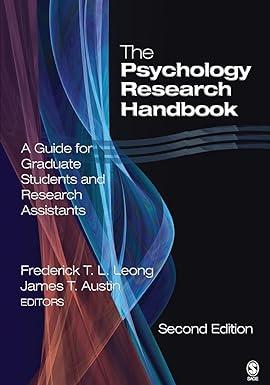Exercise 1 a. Think of a construct or variable that interests you. Try to keep your construct
Question:
Exercise 1
a. Think of a construct or variable that interests you. Try to keep your construct benign (or covering nonsensitive material) because you will eventually need to ask some of your friends or colleagues how they feel about your topic. Now write 5 to 10 items that you think are reflective of this construct. All of the items should tap the construct in some way, but don’t worry if they are not all highly relevant to the construct.
For example, if I am interested in measuring religious coping, I may ask highly relevant questions such as
(a) “When faced with a crisis in life, I often turn toward religion for comfort and support.”
(b) “When I feel stretched beyond my limits, I find prayer to be helpful in coping with it all.”
I may also ask a question that seems only somewhat related to my construct such as,
(c) “I often feel like a weight has been lifted after attending religious services.” This item doesn’t address coping with stressors by turning to religion per se, but it may tap religious sequelae that lead to more successful adjustment. The important point is to cover the breadth of the construct.
b. Once you have written your items, look them over to determine if you have violated any of the guidelines discussed under “Question Design” in this chapter. If you have, consider revising your items so that they are in line with these guidelines. For example, I may want to edit the following item to avoid the possibility of a double question.
Original item:
“When faced with a crisis in life, I often turn toward religion for comfort and support.”
Revised items:
“When faced with a crisis in life, I often turn toward religion for comfort.”
“When faced with a crisis in life, I often turn toward religion for support.”
c. Now, find three volunteers to help you pilot test your items. These people should be conveniently chosen
(e.g., friends, family, or colleagues) for this exercise. Ask them to read aloud each item that you have written.
Ask them also to think aloud by verbalizing the thought processes they go through in deciding what their response will be. (You may want to take notes.)
The purpose of this step is to determine whether the meaning of the items is the same for all interviewees.
You may want to revise your items if there were discrepancies between what you intended to ask and what your participants thought you were asking.
Step by Step Answer:

The Psychology Research Handbook A Guide For Graduate Students And Research Assistants
ISBN: 108851
2nd Edition
Authors: Frederick Leong, James Austin






